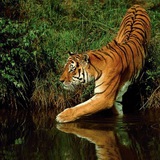
Telegram-канал wildlifen - Wildlife
 19368
19368
Join us as we explore the wilderness and share the beautiful scenery of nature! For all questions: @magellanvs

 19368
19368
Join us as we explore the wilderness and share the beautiful scenery of nature! For all questions: @magellanvs

The sound of the wings of a giant long-legged grasshopper.
It lives on the territory of New Zealand and reaches a length of up to 10 cm.

Unlike other chicken breeds, Chinese silk ones have five fingers.
Читать полностью…
Starlings have an excellent ability to onomatopoeia, including mastering human speech.
Читать полностью…
the Argyroneta aquatica water spider reaches 15 mm in length, the female - up to 12 mm; the abdomen is brown, covered with many velvety hairs and has two rows of depressed dots on the dorsal side.
When the silverfish is immersed in water, the abdominal hairs covered with a special fatty substance are not wetted, air is trapped between them, and therefore it appears silver under water (hence the name of the species). This layer of air allows the silverfish to stay underwater for a long time; the spider occasionally rises to its surface to renew the supply of air. The water-repellent substance is a modified secret of the spider glands.
A bell-shaped or funnel-shaped nest is made by a silverfish underwater from cobwebs, attaching it to various underwater objects. The spider fills the nest, which is open downwards and reaches the size of a hazelnut, with air and uses it as a kind of diving bell.

The African golden cat Caracal aurata lives in the tropical rain forests of Equatorial Africa, occurring from Senegal to northern Angola and from the Congo in the west to southern Kenya in the east. Its main population lives in the Congo basin and in the surrounding territories.
The golden cat has the same ancestor with the caracal and serval, who lived about 5 million years ago, so all these cats belong to the same genus Caracal.
A golden cat is about twice as big as a domestic one. The body length is 90-120 cm, and the tail accounts for 1/3 of the total length; the height at the withers is 40-50 cm. The average weight of males is 11-14 kg.
There is little data on the life of these cats in nature, as they are secretive and quite rare. They lead a solitary lifestyle, hunting mainly at night, and resting on the branches of trees during the day.

The parrot kea Nestor notabilis is endemic to New Zealand, outwardly similar to a falcon or a small eagle with a large head and a predatory, downward-curved beak. Despite its relatively small size, kea has remarkable strength and flies perfectly.
Body length about 45 cm, weight 600-1000 g. The color of the plumage is dominated by olive green, sometimes slightly brownish color, under the wings the feathers are painted bright red. Paws are gray. The name is onomatopoeic, derived from the loud cry: "keee-aa".
They are known for their exploratory behavior and the ability to deftly use their beak, which, combined with developed curiosity, makes them a scourge for locals and entertainment for tourists. Nicknamed the "clowns of the mountains", they do not miss the opportunity to explore the contents of backpacks or cars that they liked.

The tawny (blue-footed) heron Egretta rufescens is a permanent inhabitant of Central America, the Bahamas, the Caribbean, the Gulf coast of the United States and Mexico.
In the past, this bird was a victim of the feather trade. There are only 1,500 to 2,000 breeding pairs of tawny herons in the U.S., and most of them are in Texas, where they are classified as "endangered" and receive special protection.
The tawny heron is considered one of the most active herons, and it can often be seen in motion. It visually tracks its prey in shallow water much more actively than other herons, often running vigorously and using the shadow of its wings to reduce glare on the water.
As soon as she is in a position to hit prey with a sharp beak, the bird makes a throw. The hunting of the tawny heron can resemble an intricate dance. Because of its bold, predatory, but graceful eating behavior, author Pete Dunn nicknamed the tawny heron the "Tyrannosaurus rex of the plains."

If you are in a bad mood, then watch the squirrels water skiing competition.
Читать полностью…
Tapir proboscis is needed not only for better perception of odors.
With his help, the beast can spend several minutes underwater, which helps him hide from enemies.

Tapir proboscis is needed not only for better perception of odors.
Читать полностью…